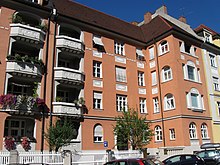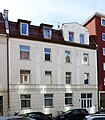Clemensstraße
 Clemensstraße 32/34 | |||
| Namesake | Clemens August of Bavaria | ||
|---|---|---|---|
| Length | 1,800 m (5,900 ft) | ||
| Location | Munich | ||
| Postal code | 80803 | ||
| Nearest metro station | Clemensstraße (Tram 27) | ||
| Major junctions | Leopoldstraße, Morawitzkystraße, Siegfriedstraße, Wilhelmstraße, Bismarckstraße, Moltkestraße, Viktoriastraße, Cherubinistraße, Ansprengerstraße, Rossinistraße, Belgradstraße, Apianstraße, Fallmerayerstraße, Erich-Kästner-Straße, Mittermayrstraße, Hiltenspergerstraße, Schleißheimer Straße, Winzererstraße | ||
Clemensstraße is a 1.76-kilometer-long street in Munich's Schwabing district. The street, named after Clemens August of Bavaria (1700–1761), labeled under the term Green Axis Schwabing is a participative model project for all Munich municipalities and Munich's longest bicycle road.[1][2]
Course[]
The Clemensstraße starts at Leopoldstraße, crosses Belgradstraße and Schleißheimer Straße and turns into Saarstraße at Winzererstraße. While in the area between Münchner Freiheit and Wilhelmstraße, relatively small shops line the street initially, Clemensstraße becomes predominantly a residential street. Until 2002, Clemensstraße 33 housed the Staatliche Fachakademie für Fotodesign München, which was founded on 15 October 1900, as the Lehr- und Versuchsanstalt für Photographie (teaching and research institution for photography). In the area of Belgradstraße, on both sides of the street are numerous restaurants to be found, especially in the summer months their free play areas shape the overal impression of the road. With several decades old traditions, such as the "X-Bar"[3] as well as the, for example, from 1972 to 1976 by Heppel & Ettlich conducted "Jennerwein".[4][5][6] Also located there, in Clemensstraße 61, was the "Clemensburg" as Munich's only BVB pub, which existed from 1907 to 2015.[7] In the further course to the east, the Clemensstraße is again primarily a residential street. In the Clemensstraße 113/IV is the Säkularinstitut Ancillae Sanctae Ecclesiae. At the corner of Clemensstraße and Winzererstraße is the Landesarbeitsgericht München (Munich Labor Court).
Historical buildings[]
In the area between Münchner Freiheit and Fallmerayerstraße, the Clemensstraße, with a length of around 1,100 m (3,600 ft), belongs to the historically protected construction ensemble Nordschwabing. Its design is mainly due to the expansion of the city after the incorporation of Schwabing in 1890 to Munich and the city expansion competition of 1892 under Theodor Fischer. Overall, the Clemensstraße has 36 historically protected monuments by the Bavarian State Office for the Preservation of monuments,[8] of which 26 are in Schwabing-West and 10 in Schwabing.

Dormitory built in 1903 by Andreas Aigner and Paul Breitsameter, Art Nouveau building at Clemensstraße 127

Built in 1900 by Gerhard Welzel, Baroque Art Nouveau corner building at Clemensstraße 71

Early 20th century built Art Nouveau building with mansard roof at Clemensstraße 66

Early 20th century built corner building with bay windows and plaster decoration in forms of late Art Nouveau at Clemensstraße 38

Baroque style Art Nouveau building built in the early 20th century at Clemensstraße 26

Sculpture by the sculptor Klaus Behr at Clemensstraße 48

1979 by Undine Werdin created sculpture (Daphne) at the southern end of the Clemensstraße
Famous residents[]
1884/85, the former Schwabing Hospital was built in Clemensstraße 33.[9] In the spring of 1900, the stove and oven manufacturer Friedrich Wamsler, whose sons were among the founding members, gave FC Bayern Munich a fenced plot of land on Clemensstraße as a venue, until 1907 when he moved to Leopoldstraße and Parzivalplatz[10] Here the first Munich City Derby also took place on 21 September 1902.
From 1906 to 1910, Alexander Roda Roda lived in Clemensstraße 2.[11] From 1917 to 1919 Ret Marut lived in Clemensstraße 84 /III and led the editorship of Der Ziegelbrenner ("The Brick Burner") there.[12]
From autumn 1967, Edgar Hilsenrath lived in the Clemensstraße 28.[13] Rainer Werner Fassbinder and Juliane Lorenz lived in Clemensstraße 76, as well as Alexander Koester who lived on Clemensstraße (while his studio was on Leopoldstraße).[14] Jochen Winter lived on Clemensstraße.[15]
References[]
- ^ Myriam Siegert (26 April 2013). "Hier haben Autofahrer (fast) nichts zu melden" (in German). Abendzeitung München. Retrieved 18 April 2018.
- ^ "»Grüne Achse Schwabing« ist ein Modellprojekt für alle Viertel" (in German). Wochenanzeiger. 13 May 2014. Retrieved 18 April 2018.
- ^ Beate Wild (26 October 2010). "Schwabinger Trash" (in German). Süddeutsche Zeitung. Retrieved 18 April 2018.
- ^ Lars Langenau (17 November 2011). "In der Höhle des Wilderers" (in German). Süddeutsche Zeitung. Retrieved 18 April 2018.
- ^ Thierry Backes (22 August 2012). ""Die Mutter aller Pinten"" (in German). Abendzeitung. Retrieved 18 April 2018.
- ^ Ursula Auginski (21 August 2008). "Alpenkitsch und Diva Desaster" (in German). Süddeutsche Zeitung. Retrieved 18 April 2018.
- ^ Ellen Draxel (11 May 2015). "Der Kampf ums Wohnzimmer". Süddeutsche Zeitung (in German). Süddeutsche Zeitung. Retrieved 18 April 2018.
- ^ "Baudenkmäler München" (PDF) (in German). Landesamt für Digitalisierung, Breitband und Vermessung. 11 April 2018. Retrieved 18 April 2018.
- ^ "Vorgeschichte: 13. bis 19. Jahrhundert" (in German). Städtisches Klinikum München. Retrieved 18 April 2018.
- ^ Corinna Erhard (24 November 2011). "Die München-Frage: Warum spielte der FC Bayern anfangs in Blau?" (in German). Münchner Merkur. Retrieved 18 April 2018.
- ^ Robert Schurz (21 April 2013). "Alexander Roda Roda in München" (in German). Bayerischer Rundfunk. Retrieved 18 April 2018.
- ^ W. Stock (10 August 2010). "B. Traven wohnt in München, Clemensstrasse 84". stockpress.de (in German). Retrieved 18 April 2018.
- ^ Braun, Helmut (23 May 2014). Ich bin nicht Ranek: Annäherung an Edgar Hilsenrath (in German). Berlin: Dittrich Verlag.
- ^ Stein, Ruth (1988). Alexander Koester 1864-1932. Leben und Werk (in German). Recklinghausen: Bongers. ISBN 3764703997.
- ^ Bayerische Akademie der Schönen Künste Jahrbuch 15 (in German). München: Verlag C.H.Beck. 1 January 2001. ISBN 3923657684.
External links[]
| Wikimedia Commons has media related to Clemensstraße (München). |
- Streets in Munich
- Buildings and structures in Munich
- Historicist architecture in Munich






